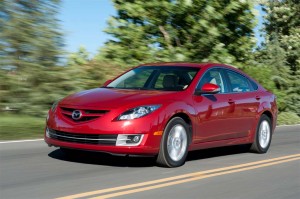
Mazda is expected to abandon the U.S. plant it now operates with Ford and may also cancel production of the midsize Mazda6.
Mazda appears ready to end a nearly quarter century-old joint venture with Ford Motor Co. and stop producing cars in the United States.
The apparent decision reflects the fact that Ford has sold off all but a small portion of its holdings in the Japanese maker – as well as the reality that the Mazda6 model produced in the Flat Rock, Michigan plant has not been doing well in the American market.
Officially known as AutoAlliance International, the plant was opened in 1987 and marked the high-water point in the long-running relationship between Mazda and Ford. The U.S. maker had acquired a controlling stake in its Asian ally, which was then struggling to overcome a series of setbacks. Ford even got to name the CEO at Mazda and appointed a number of Western managers – a rarity at the time.
Meanwhile, the two makers began to synchronize their product development programs, the underpinnings of the upcoming Ford C-Max, for example, are rooted in the same initial program that developed the recently-launched Mazda5 microvan.
But the relationship have been cooling in recent years. Mazda has sought more independence. Ford, meanwhile, has shifted its own focus since CEO Alan Mulally came onboard, four years ago, and put an emphasis on the company’s two core brands, the Ford division and Lincoln.
But while Ford has trimmed its stake in Mazda to just 3.5%, company officials, including the Japanese maker’s President Takashi Yamanouchi, have insisted they would continue to cooperate. The question is to what degree?
Rumors that the fate of the Flat Rock plant might be under discussion have been circling for some months, and Japan’s influential business paper, the Nikkei, is reporting Mazda wants to realign its global production strategy. While Jim O’Sullivan, CEO of Mazda’s U.S. subsidiary, has set a goal of doubling the maker’s stake in the American market, it looks like it would still not necessarily need the AutoAlliance plant.
If Mazda did pull out, it would become only the second Japanese automaker to abandon a U.S. production base, following the struggling Isuzu, which walked away from its partnership in an Indiana plant also operated by Fuji Heavy Industries, parent of Subaru.
For its part, Mazda issues a terse release stating, “Mazda and Ford are jointly studying various possibilities for AAI, and we have nothing to announce at this time,” adding “We do not comment on speculation.”
The latest reports raise several other questions: most immediately, what will Mazda do without the Flat Rock plant. There have been several reports, in recent months, suggesting it would drop the slow-selling Mazda6, for one thing.
But one of the problems for Mazda has been its heavy dependence on Japanese manufacturing. With the yen gaining strength against the dollar, vehicles imported from the home market have lost much of their profit margin. That’s a key reason Mazda’s losses for the fiscal year ending March 31 jumped to 60 billion yen, or $742 million, compared with a 6.5 billion yen loss the year before.
Mazda could, however, turn to Mexico to serve the U.S. market, as a number of other makers are doing.
Meanwhile, it is uncertain whether Ford could or would justify maintaining the Michigan plant – one of the few facilities operated by a Japanese maker with union representation – if Mazda moved out. Currently the facility also produces the Mustang, but that demand alone would not justify the large facility, which employs 1,700 workers on a single shift.
